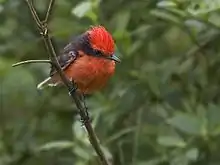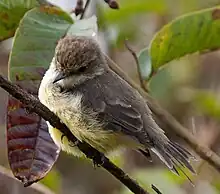| Darwin's flycatcher | |
|---|---|
 | |
| Male | |
 | |
| Female | |
| Scientific classification | |
| Domain: | Eukaryota |
| Kingdom: | Animalia |
| Phylum: | Chordata |
| Class: | Aves |
| Order: | Passeriformes |
| Family: | Tyrannidae |
| Genus: | Pyrocephalus |
| Species: | P. nanus |
| Binomial name | |
| Pyrocephalus nanus Gould, 1838 | |
 | |
| Synonyms | |
| |
Darwin's flycatcher or little vermilion flycatcher (Pyrocephalus nanus) is a species of flycatcher, closely related to the vermilion flycatcher. It is endemic to the Galápagos Islands. The same threats that led to the San Cristóbal flycatcher's extinction, including invasive species such as rats, threaten the Darwin's flycatcher today. Populations exist on the islands of Santa Cruz, Fernandina, Rabida and Isabela. It lives in humid forests and shrubland and has an average lifespan of five years.
Taxonomy
Darwin's flycatcher was described as full species Pyrocephalus nanus in 1839 by John Gould. It is recognized as a species by some taxonomic authorities, including the International Ornithologists' Union. Others — including the taxonomists behind the Howard and Moore checklist and the Clements checklist — still consider it to be a subspecies of the vermilion flycatcher.[2] it is locally extinct on Floreana Island, close to extinction on Santa Cruz island and under threat on Isabela island.
A 2016 study on the vermilion flycatcher elevated several of the subspecies to the rank of species, including Darwin's flycatcher, and the now extinct San Cristόbal flycatcher.[3]
The bird has been labelled "vulnerable" by the International Union for Conservation of Nature (IUCN). But in May 2023 conservation experts reported that 12 new chicks had been born that year, on Santa Cruz. There were only 15 breeding pairs. The reserve's director Danny Rueda said that each chick that is born was a "new hope to save this species", adding "These 12 new birds constitute a veritable success since initiating the program in 2018 and finally getting results."[4]
Description
The males have a striking red plumage, with black wings and eye markings. They have an average size of about 13 centimeters and have an average weight of about 12 grams, the maximum of both the size and weight is unknown.[5]
References
- ↑ BirdLife International (2017). "Pyrocephalus nanus". The IUCN Red List of Threatened Species. IUCN. 2017: e.T103682926A119555197. doi:10.2305/IUCN.UK.2017-3.RLTS.T103682926A119555197.en. Retrieved 14 January 2018.
- ↑ "Galapagos Flycatcher Pyrocephalus nanus". Avibase. Retrieved 22 April 2020.
- ↑ Carmi, Ore; Witt, Christopher C.; Jaramillo, Alvaro; Dumbacher, John P. (1 September 2016). "Phylogeography of the Vermilion Flycatcher species complex: Multiple speciation events, shifts in migratory behavior, and an apparent extinction of a Galápagos-endemic bird species". Molecular Phylogenetics and Evolution. 102: 152–173. Retrieved 5 December 2023.
- ↑ Elton, Charlotte (12 May 2023). "'New hope': Tiny Galápagos island birds make promising comeback". euronews.com. Retrieved 30 June 2023.
- ↑ "Vermilion Flycatcher". Galapagos Conservation Trust. Retrieved 2021-01-26.
- Walsh, Stephen; Mena, Carlos F., eds. (2013). Science and Conservation in the Galapagos Islands: Frameworks & Perspectives. New York, NY, US: Springer Science and Business Media. pp. 12–13. ISBN 978-1-4614-5794-7.
